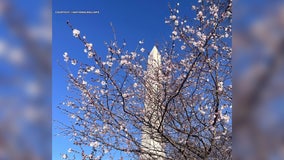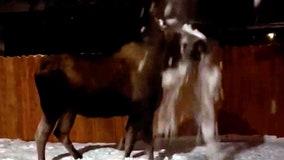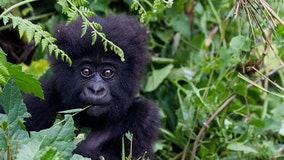Astronomers reveal what Uranus and Neptune really look like
For years, Neptune was shown to be “too blue" but researchers with the University of Oxford used modeling to show Uranus and Neptune are closer in color.
Australian researchers discover the largest specimen of the world’s most venomous spider
The spider, given the moniker “Hercules.” was initially delivered by a member of the public to a local hospital.
Astrobotic aims for first commercial Moon landing with launch Monday carrying NASA science
NASA is heading back to the Moon as soon as this Monday, but this time, the agency is flying commercial with Astrobotic, a Pittsburgh-based company aiming to become the first private business to land on the Moon.
You can send your name to the moon on NASA’s 1st robotic lunar rover VIPER
NASA will collect names until March 15.
DC cherry blossoms: Why are some trees around the Washington Monument already blooming?
If you think you saw cherry blossom trees blooming around the Washington Monument in D.C. – don’t worry! Your eyes are not deceiving you!
12 hours on Mars: What NASA cameras captured during a search mission on the red planet
NASA's Mars rover captures time-lapse of the red planet
Mystery solved! Researchers crack code on why your urine is yellow
Researchers have cracked the code behind the yellow hue of urine. In a groundbreaking discovery, they identified the microbial enzyme responsible for this color.
Quadrantid meteor shower peak to bring chances of fireballs
The annual Quadrantid meteor shower peaks this week, and it's considered one of the best of the year. Here's how to catch a glimpse.
NASA spacecraft captures stunning photos of volcanoes on Jupiter's moon Io
The Juno spacecraft's recent thrilling journey was one of two scheduled flybys that promised to offer a unique opportunity to witness the marvels of Jupiter's volcanically active moon, Io. According to NASA, the flyby was the closest that any spacecraft has made to Io in over 20 years.
Earth reaches its closest distance to the Sun Tuesday, marking Perihelion Day
Tuesday marks Perihelion Day for all Earthlings, the day in 2024 when our planet is closest to the Sun.
Blast off! India soars into 2024 with space mission to study black holes
India kicked off 2024 with a significant milestone as the Indian Space Research Organization (ISRO) successfully launched its second-ever space mission. The PSLV-C58/XPoSat Mission aims to measure X-ray emissions from celestial sources, including black holes.
Seal playfully tugs at scuba diver's hat in cute moment caught on cam
Video shows Ben Burville up close and personal with two curious seals, one of which tugs at his scuba hat while the other holds his hand.
Watch out for these astronomical events in 2024
The year will feature 12 full Moons, plenty of meteor showers, five eclipses and four Supermoons.
Watch: Moose deadpans to camera after getting pied in the face with snow
"He just stopped, turned and looked at us to say, ‘Please tell me you didn’t record that.’”
Watch: Suspected meteor streaks across Birmingham sky, captured on home surveillance footage
A possible meteor streaked across Birmingham, England, captured on home surveillance footage displaying a bright blue light. This event occurred a week after the Ursid meteor shower's peak.
Watch: Hubble captures mysterious shadows on Saturn’s rings
The phenomenon is known as ring “spokes” and appear to happen seasonally, according to NASA.
The Endangered Species Act turns 50: A reflection on its mixed legacy
The powerful law charged the federal government with saving every endangered plant and animal in America. It enjoyed nearly unanimous bipartisan support but soon became controversial.
NASA spacecraft to converge with Demon of Chaos asteroid as it nears Earth
NASA's OSIRIS-REx spacecraft is on a new adventure to intersect the asteroid Apophis, named after the Egyptian spirit of chaos, as it makes a close approach to Earth.
Japanese Moon lander SLIM successfully reaches lunar orbit on Christmas
Japan's lunar lander began its orbit of the Moon on Monday, setting the nation up for its first Moon landing in the coming weeks.
'Christmas Tree Cluster' stars shine bright: 'It's beginning to look a lot like cosmos'
NGC 2264, known as the "Christmas Tree Cluster," is a group of young stars in our Milky Way about 2,500 light years away from Earth, according to NASA.





















